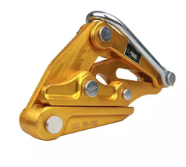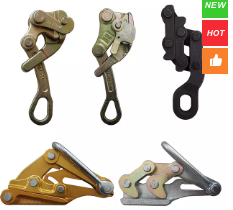
Introduction
When it comes to lifting, pulling, or moving heavy loads, selecting the right tool is essential. Two commonly used tools for such tasks are the come along and the winch. Although these tools are designed with the same general purpose in mind, they differ significantly in terms of their design, operation, and suitability for various tasks.
The come along is a manual tool often used for smaller, more specific jobs such as pulling a vehicle out of a ditch or securing a load. On the other hand, the winch is typically a more powerful, motorized tool designed to handle larger and more demanding jobs, such as off-road vehicle recovery, lifting heavy construction materials, or moving industrial equipment.
In this article, we will explore the differences between a come along and a winch, examining their unique features, capabilities, and applications. By the end of this article, you'll be equipped to make an informed decision about which tool best suits your needs, whether you are recovering a vehicle, securing materials, or moving heavy objects.
Understanding a Come Along and a Winch
To effectively compare these two tools, it is essential to understand their mechanics and the role they play in various applications.
What is a Come Along?
A come along is a manually operated tool that is primarily used to pull, lift, or move objects. It operates using a ratchet mechanism, where a handle is used to wind a cable or chain around a drum. As the handle is turned, the cable tightens and pulls the object towards the tool. The design of a come along is relatively simple, which makes it highly portable and easy to use in small, confined spaces.
Common applications of a come along include:
Recovering vehicles from muddy ditches or snowbanks
Securing loads on trucks or trailers
Tightening cables or ropes in construction and fencing applications
Lifting objects over short distances
The main advantage of a come along is its simplicity and portability. It is easy to carry, does not require a power source, and can be used in remote locations or emergencies. However, its load capacity and the physical effort required to operate it are limitations that need to be considered.
What is a Winch?
A winch, unlike a come along, is typically powered by an electric motor, hydraulic system, or a vehicle's engine. It consists of a drum that is wound with a cable or rope, and the motor or engine turns the drum to wind the cable in and pull the load toward the winch.
There are various types of winches:
Electric winches: Powered by electric motors, commonly used for automotive, off-roading, and industrial purposes.
Hydraulic winches: Powered by hydraulic systems, typically found in heavy-duty applications such as construction and forestry.
Manual winches: Similar in design to a come along, but with the added benefit of more capacity and the ability to operate over longer distances.
Winches are most commonly used for:
Recovering vehicles stuck off-road or in snow
Lifting heavy materials on construction sites
Pulling large objects such as boats or logs
Securing large equipment in various industrial settings
The winch's power makes it ideal for heavy-duty lifting, pulling, and recovery tasks.
Differences Between a Come Along and a Winch
Now that we have an understanding of what a come along and a winch are, let’s dive into the key differences that distinguish these two tools. These differences primarily focus on the power source, load capacity, operation range, portability, and ease of use.
1. Power Source
Come Along: A come along is a manual tool that requires the operator to exert physical effort. The handle is turned to engage the ratchet mechanism, which pulls the load. This makes it ideal for situations where power sources like electricity or a vehicle engine are unavailable or unnecessary.
Winch: A winch is a powered tool, often operated using electricity, hydraulics, or a vehicle engine. This power allows winches to pull much heavier loads over greater distances with minimal physical effort from the operator.
2. Load Capacity
Come Along: A come along is typically suitable for light-duty applications, with load capacities ranging from 2 to 5 tons. This makes it perfect for tasks like recovering a car from a ditch, pulling lighter materials, or securing loads on trailers.
Winch: Winches are designed to handle much heavier loads, often in the range of 2 to 20 tons or more. This capacity makes them suitable for heavy-duty tasks like pulling large construction equipment, recovering trucks, or lifting industrial machinery.
3. Distance of Operation
Come Along: A come along is designed for short-distance pulling. The cable typically extends between 10 to 30 feet, making it suitable for small tasks where the load needs to be moved only a short distance.
Winch: Winches are capable of pulling objects over longer distances, with cables that can span up to 100 feet or more. This makes winches the preferred tool for tasks requiring long-distance recovery, such as off-roading or industrial lifting operations.
4. Portability
Come Along: One of the biggest advantages of a come along is its portability. These tools are compact, lightweight, and easy to carry. Since they don’t require a power source, they can be used in remote locations or during emergencies without the need for external electricity or fuel.
Winch: Winches, while more powerful, tend to be bulkier and require a power source. Many winches are mounted on vehicles, trailers, or stationary locations, which limits their portability. However, portable electric or hydraulic winches do exist, though they are still heavier and more cumbersome than a come along.
5. Ease of Use
Come Along: The manual operation of a come along is relatively simple. It requires minimal training, and the operator only needs to turn the handle to engage the ratchet mechanism and pull the load. However, it does require physical effort, especially when dealing with heavier loads.
Winch: A winch is typically easier to operate in terms of physical effort, as it is powered. However, winches often involve more complex setups and controls, especially electric or hydraulic models. These require a better understanding of how the system works, but once set up, they can be used with minimal physical effort.

Tips for Choosing a Come Along and a Winch for Different Areas
When selecting a come along or winch, you should consider the specific task at hand. Below are some helpful tips for choosing the right tool based on the application.
1. For Vehicle Recovery
Come Along: If you're recovering a vehicle from a ditch or snowbank and you have limited space or no access to power sources, a come along is a great option. However, make sure it has a sufficient load capacity to handle the weight of the vehicle.
Winch: For more heavy-duty vehicle recovery, especially for larger vehicles or if the recovery involves greater distances or challenging terrain, a winch is a much better option. Winches are ideal for off-road recoveries and for pulling vehicles over long distances.
2. For Construction and Heavy Lifting
Come Along: Use a come along when you need to move lighter materials or adjust cables in construction settings. It's perfect for securing loads or making small adjustments without the need for heavy machinery.
Winch: For more demanding tasks, such as lifting heavy beams or moving large machinery, a winch is the best choice. Winches provide the power required for industrial-level lifting and moving, making them ideal for large construction projects.
3. For Outdoor Recreation
Come Along: For outdoor enthusiasts who enjoy off-roading, camping, or hiking, a come along is an ideal tool. It's lightweight, easy to store, and can be used in remote areas where there is no power supply.
Winch: For more frequent off-roading or boating trips, having a winch can be crucial for recovering stuck vehicles or lifting large equipment. Winches can recover vehicles stuck in challenging environments like mud or sand, and they offer more pulling power when needed.
Conclusion
In conclusion, both a come along and a winch are essential tools for handling heavy loads, but they serve different purposes. The come along is ideal for light-duty tasks that require portability, ease of use, and minimal effort. It excels in situations where you need to pull or secure smaller loads over short distances, such as recovering a car from a ditch or tightening cables.
On the other hand, the winch is a more powerful, motorized tool that is suited for heavy-duty tasks. It can handle larger loads, operate over longer distances, and provide greater lifting and pulling power with minimal physical effort from the operator. Winches are perfect for industrial-level tasks, off-roading, and marine applications, where heavy lifting and long-distance pulling are required.
For those looking for a high-quality and reliable come along, [[JITAI Electric Power Equipment Co., Ltd.]] offers premium products designed to meet both personal and professional needs. Their come along models are engineered with durable materials and advanced mechanics, ensuring long-lasting performance even in demanding conditions. Whether you're working in construction, vehicle recovery, or securing heavy equipment, their products provide the strength and reliability you need. The company’s commitment to quality and customer service ensures that you get the best value for your investment.
Explore JITAI Electric Power Equipment Co., Ltd. for more information on their full range of products, including their well-regarded come along solutions available. By choosing us, you can trust that you're getting a product that will help you handle even the toughest lifting and pulling jobs with ease.
FAQ
Is a Come Along and a Winch the Same Thing?
No, a come along is a manual tool, while a winch is typically powered. A winch is generally used for heavier, more industrial tasks, while a come along is suited for lighter, short-distance tasks.
Can You Use a Come Along as a Hoist?
While a come along is not traditionally used as a hoist, it can be used for small-scale lifting tasks, such as lifting a load off the ground for a short distance.
Can a Come Along Pull a Truck Out?
Yes, a come along can pull a truck out of a ditch or mud, provided the truck's weight is within the tool's load capacity.
What Do You Use a Come Along For?
A come along is typically used for tasks that require short-distance pulling or lifting, such as recovering vehicles, tightening cables, or securing loads.

















